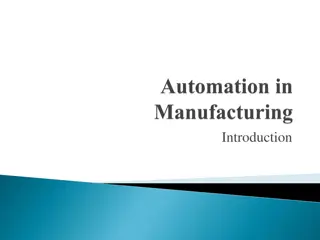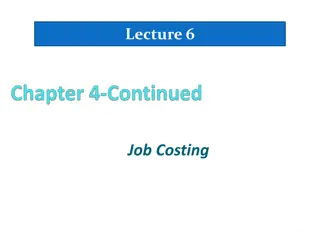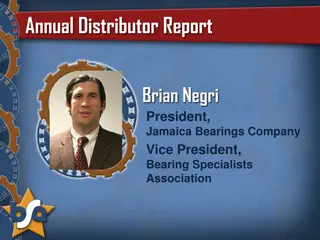Transforming India's Manufacturing Sector: A New Vision
India is focused on becoming a global manufacturing hub by promoting growth, facilitating investment, and enhancing industrial infrastructure. The key pillars for this transformation include improving the business environment, enabling industrial corridors, fostering innovation, and opening up to foreign direct investment in critical sectors. Initiatives such as online industrial licensing, deregulation, and simplifying regulatory processes aim to streamline operations and attract investments.
Download Presentation

Please find below an Image/Link to download the presentation.
The content on the website is provided AS IS for your information and personal use only. It may not be sold, licensed, or shared on other websites without obtaining consent from the author.If you encounter any issues during the download, it is possible that the publisher has removed the file from their server.
You are allowed to download the files provided on this website for personal or commercial use, subject to the condition that they are used lawfully. All files are the property of their respective owners.
The content on the website is provided AS IS for your information and personal use only. It may not be sold, licensed, or shared on other websites without obtaining consent from the author.
E N D
Presentation Transcript
New Government, new directions for a vibrant economy 3
Our mandate is to put India on a world map as a Manufacturing hub Promoting growth of manufacturing industry & facilitating investment Framing Foreign Direct Investment (FDI) Policy, facilitating foreign investment & bilateral/multilateral engagements for industry and investment Administering intellectual property regime consistent with international commitments Facilitating development of industries through up-gradation of industrial infrastructure Responsibility as Administrative Ministry for specific industries allocated to the Department, viz cement, paper, boiler, leather, rubber, light engineering, salt and consumer industries 4
Three pillars for bringing out transformation in manufacturing have been defined Improving Business Environment Ease of Doing Business De-licensing & Deregulation Enabling Manufacturing Industrial Corridors Industrial Clusters Smart Cities Nurturing Innovation Skill Development Opening up Foreign Direct Investment in key sectors Opening of critical sectors like Defense, construction and Railways for FDI 5
Improving Business Environment Process of applying for Industrial License & Industrial Entrepreneur Memorandum made online on 24X7 basis through eBiz portal Validity of Industrial license extended to three years States asked to introduce self-certification and 3rd Party certification under Boilers Act Major components of Defence products list excluded from industrial licensing Dual use items having military as well as civilian applications deregulated Services of all Central Govt. Departments & Ministries will be integrated with the E-Biz - a single window IT platform for services- by 31 Dec. 2014 6
Improving Business Environment Advisory sent to all Departments/ State Governments to simplify and rationalize regulatory environment: All returns should be filed on-line through a unified form; A check-list of required compliances should be placed on Ministry s/Department s web portal; All registers required to be maintained by the business should be replaced with a single electronic register; No inspection should be undertaken without the approval of the Head of the Department; and For all non-risk, non-hazardous businesses a system of self- certification should be introduced 7
Enabling manufacturing Impetus on developing Industrial Corridors and Smart Cities Chennai-Bengaluru Industrial Corridor: Master Planning for 3 new Industrial Nodes [Ponneri (TN), Krishnapatnam (AP), Tumkur (Karnataka)] in progress. Delhi-Mumbai Industrial Corridor: work on 5 smart cities in progress: Dholera, Shendra-Bidkin, Greater Noida , Ujjain and Gurgaon North-East Corridor Linked to Myanmar & other Industrial Corridors A new National Industrial Corridor Development Authority being created to coordinate, integrate, monitor and supervise development of all Industrial Corridors. Bengaluru Mumbai Economic Corridor Amritsar-Kolkata Industrial Corridor: Chennai-Vizag Industrial Corridor: Feasibility Study commissioned by ADB. DMICDC selected as Nodal Agency for doing Feasibility Study, which is being conducted at fast pace. 100 days of the New Government 8
Enabling manufacturing New Industrial Clusters for promoting advance practices in manufacturing Use of recycled water through zero liquid discharging systems With an emphasis on Approval accorded to 21 Industrial projects under Modified Industrial Infrastructure Upgradation Scheme Central Effluent Treatment plants Under NMP, one additional National Investment and Manufacturing Zone (NIMZ) at Kalinganagar, Jajpur district in Odisha given in-principle approval, bringing the number to 17 9
Enabling manufacturing Nurturing Innovation Approval obtained for strengthening Intellectual Property regime in the country through: Creation of 1033 posts Further upgradation of IT facilities Act recognizing National Institute of Design (NID), Ahmedabad, as an institute of National Importance notified on 8th August 2014. This will enable it to confer degrees, promote research and function as an Apex body in Design Education. 4 NIDs being developed 100 days of the New Government 10
Enabling manufacturing Skilling the youth Training imparted to 51,216 youth Impetus given to skill development through Indian Leather Development Programme For augmentation of training infrastructure, funds released for establishment of 2 new branches of Footwear Design & Development Institute at Banur (Punjab) and Ankleshwar (Gujarat) 11
Opening up Foreign Direct Investment in key sectors 100% FDI under automatic route permitted in construction, operation and maintenance in specified Rail Infrastructure projects Policy in Defence sector liberalised and FDI cap raised from 26% to 49%. Easing of norms underway for FDI in the Construction Development sector 12
India on a growth path GDP Growth GDP growth rate improved to 5.7% in the first quarter (April-June) of 2014 compared to 4.7% in first quarter of 2013 Industry GDP growth rate spiked at 4.2% in the first quarter of 2014 compared to -0.4% in the first quarter of 2013. Industry GDP growth rate also spiked to 3.5% in Q1 of 2014 compared to -1.2% in the corresponding Q1 of 2013 13 Source: DIPP
India on a growth path FDI Inflows M-o-M FDI inflows increased from USD 1.4 bn in June 2013 to USD 1.9 bn in June 2014 recording an increase of 33%. 33% FDI Inflows Foreign Direct Investment inflows have increased 75% in the months of June-July 2014 (combined) over the same time period in the preceding year. 75% 14 Source: DIPP
India on a growth path Industrial Growth The performance of industrial sector as measured by growth of Index of Industrial Production (IIP), has improved in June 2014 as compared to June 2013 Industrial Growth Performance of Capital goods, which is an indicator of revival of positive investment sentiment has shown considerable improvement in June 2014 as compared to June 2013. 15 Source: DIPP
India on a growth path Trade Manufacturing (Exports Selected Major Commodities) Most of the manufactured products have witnessed a positive growth in exports in July 2014 as compared to July 2013 16 Source: DIPP
Improving sentiments Manufacturing Purchasing Managers Index (HSBC) HSBC PMI which gives an overview of business conditions in manufacturing sector was a 17-month high in July 2014 at 53.0 Business Confidence Index (NCAER) Business Confidence Index rose by 13% in June over April 2014, overshadowing 3.8% increase in April over January, 2014. 17 Source: DIPP
Road Ahead Hon ble Prime Minister, in his Speech from ramparts of Red Fort on Independence Day on August 15, 2014 has defined future course of action: over . ...Come, Make In India. Sell anywhere but manufacture here ... .. I want to appeal all the people world way that they carry zero defect, that our exported goods are never returned to us. We should manufacture goods with zero effect that they should not have a negative impact on the environment. We should manufacture goods in such a 18























